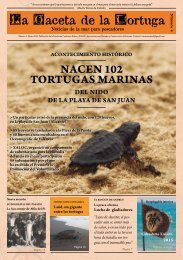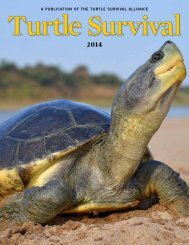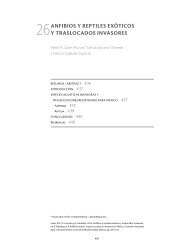tsrp63entire
tsrp63entire
tsrp63entire
You also want an ePaper? Increase the reach of your titles
YUMPU automatically turns print PDFs into web optimized ePapers that Google loves.
5.1 Management<br />
5.1.1 Topic 1—Distribution<br />
Owing to the cryptic, nocturnal nature of native frogs and the likelihood of frog populations<br />
occurring in low densities, our knowledge of the present-day distribution of native frog species<br />
may be incomplete. The discovery of native frog populations on Maungatautari in 2004<br />
(Baber et al. 2006) and in Titirangi in 2010 (T. Wilson, pers. comm.) indicates that as-yet<br />
undiscovered native frog populations could still exist elsewhere. Although historical surveys<br />
have been conducted, these used a variety of techniques and results were not always reported<br />
where no frogs were located, suggesting that the currently documented distribution of<br />
Leiopelma species may not reflect their true distribution. Therefore, targeted and standardised<br />
survey methods should be used when searching for native frogs to provide confidence in the<br />
results. Search effort should be focused on sites suitable for native frogs and results must be<br />
reported so that an accurate map of native frog distribution can be built. Standardised methods<br />
that could be used by external parties surveying native frog habitat or known areas of low-density<br />
frog populations would also be valuable.<br />
Issues<br />
Issue 1.1:<br />
Issue 1.2:<br />
Variable survey methods for native frogs have been used in the past, yielding<br />
incomparable results, and the reporting of results has not always occurred.<br />
Many areas of New Zealand have not been specifically surveyed for native frogs, yet<br />
appear to contain suitable habitat, including areas where subfossil frog remains have<br />
been found.<br />
Objectives and actions<br />
Objective 1.1:<br />
Objective 1.2:<br />
To better understand the current distribution of native frogs.<br />
To make information on the past and present distribution of native frogs<br />
available to aid native frog recovery throughout the term of this plan.<br />
Action Accountability Priority<br />
1.1 Prepare distribution survey best practice guidelines<br />
for all users, detailing survey techniques, and<br />
reporting and data management requirements by<br />
2015, and apply throughout the term of this plan.<br />
1.2 Identify priority sites for native frog surveys by 2015<br />
and undertake surveys by 2018.<br />
Recovery Group<br />
Science and Capability Group<br />
Relevant Conservation Services Group staff<br />
Recovery Group<br />
Science and Capability Group<br />
Essential<br />
High<br />
14 Bishop et al.—Native frog recovery plan, 2013–2018





